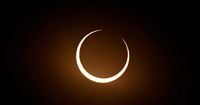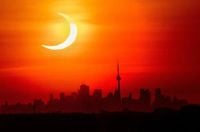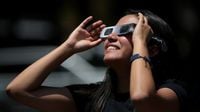On Saturday, March 29, 2025, a partial solar eclipse will captivate millions across the Northern Hemisphere, marking a significant astronomical event that promises to draw attention from both seasoned astronomers and casual observers alike. This celestial phenomenon occurs when the Moon passes between the Earth and the Sun, casting a shadow that partially obscures the Sun's light. The eclipse is expected to begin early in the morning and will be visible in various regions, including Spain, Mexico, the United States, Canada, and parts of the Caribbean.
In Spain, the eclipse will first be visible in the Canary Islands, with Santa Cruz de Tenerife experiencing the event beginning at 09:15 AM local time. The peak of the eclipse will occur at 10:04 AM, concluding at 10:56 AM. Major cities on the Spanish mainland will also witness the eclipse, with notable timings: Barcelona at 11:48 AM, Madrid at 11:40 AM, Bilbao at 11:46 AM, Valencia at 11:42 AM, Seville at 11:31 AM, and Pontevedra at 11:38 AM. According to Miguel López-Alegría, an astronaut, the event is a great opportunity for both enthusiasts and the general public to engage with astronomy.
Across the Atlantic, the eclipse will also be visible in Mexico, where it is expected to occur during the morning hours. The partial solar eclipse will be observable from nearly every corner of the country, with states like Coahuila, Chihuahua, Sonora, Durango, and Nuevo León likely to experience significant changes in ambient light. As the eclipse unfolds, observers will notice a dramatic dimming of sunlight, a moment that many find both awe-inspiring and humbling.
NASA and the Instituto de Astrofísica de Canarias (IAC) highlight the eclipse's scientific importance. Such events allow researchers to study the solar corona, the outer atmosphere of the Sun, which is otherwise challenging to observe. The partial eclipse will enable scientists to gather valuable data while also captivating the public's imagination.
However, safety is paramount during such astronomical events. The General Council of Colleges of Opticians-Optometrists (CGCOO) has issued strong recommendations for safe viewing. They advise using eclipse glasses that meet the international standard ISO 12312-2, ensuring adequate protection against harmful solar radiation. Looking directly at the Sun, even during a partial eclipse, can lead to severe eye injuries, including permanent damage to the retina and conditions such as solar retinopathy. "It's important to remember that damage can be gradual, manifesting over time, so prevention is key," noted a CGCOO representative.
For those without access to certified eclipse glasses, alternative methods of safe observation include creating a pinhole projector using simple materials like cardboard. This method allows viewers to see the eclipse's image projected onto a surface without looking directly at the Sun. Additionally, telescopes and cameras should be equipped with proper solar filters to avoid severe damage.
The excitement surrounding this eclipse is heightened by its timing. As it coincides with the Moon's perigee, or its closest approach to Earth, observers can also enjoy a supermoon effect, making the Moon appear larger and brighter than usual. This unique combination of a supermoon and a partial solar eclipse is a rare treat for skywatchers.
Beyond the immediate spectacle, this eclipse is part of a series of astronomical events. Following this partial solar eclipse, a total lunar eclipse will occur on September 7, 2025, and another partial solar eclipse will follow on September 21, 2025. Looking ahead, total solar eclipses will be visible in Spain on August 12, 2026, and August 2, 2027, with an annular eclipse set for January 26, 2028.
As the date approaches, anticipation builds. Many are preparing to gather in parks, backyards, and public spaces to witness the event together. It's a reminder of our shared connection to the cosmos and the natural rhythms that govern our world. Such moments of collective awe can foster a sense of community, as people from all walks of life come together to marvel at the wonders of the universe.
In conclusion, the partial solar eclipse on March 29, 2025, offers a unique opportunity for millions to engage with the cosmos safely and meaningfully. As viewers prepare to witness this celestial dance, the importance of proper safety measures cannot be overstated. With the right precautions, this event promises to be not just a spectacle, but a celebration of our place in the universe.









